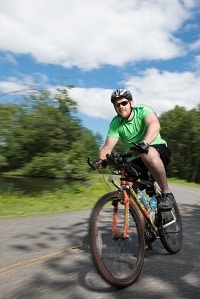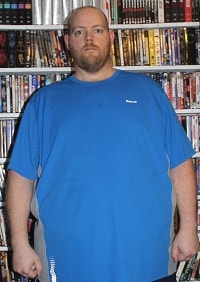Robotic Vertical Sleeve Surgery
The wave of the Future
 Strangers approach Stop & Shop Deli Manager James Boucher several times per week, praising his appearance and commenting on how different he seems. Since his weight loss surgery in October 2014, James has shed nearly 150 pounds, revamped his diet and built his endurance enough to sustain him on 25 mile bike rides. Regular customers remembered him when he was 413 pounds* and wanted to know how he had achieved such dramatic results.
Strangers approach Stop & Shop Deli Manager James Boucher several times per week, praising his appearance and commenting on how different he seems. Since his weight loss surgery in October 2014, James has shed nearly 150 pounds, revamped his diet and built his endurance enough to sustain him on 25 mile bike rides. Regular customers remembered him when he was 413 pounds* and wanted to know how he had achieved such dramatic results.
“I don’t shy away from telling them what I did and why I did it,” says 36-year-old James, a resident of Milford. “I want to be able to help someone have a new start like I had.”

James before surgery
James credits his new start to laparoscopic robotic-assisted vertical sleeve gastrectomy. Based out of The Center for Weight Loss Surgery at Milford Regional, the FreshStart program provides bariatric surgery to individuals with a body mass index (BMI) greater than 40, or 35 if there are accompanying weight-related illnesses such as diabetes, sleep apnea or arthritis.
Dr. Philip A. Cohen, one of Milford Regional’s bariatric surgeons, explains that vertical sleeve gastrectomy is a wonderful operation and that the newer robotic component offers bonus benefits for both the surgeon and patient. With conventional laparoscopy, the surgeon must look up and away from the instruments, to a nearby 2D video monitor to see an image of the target anatomy. The surgeon must also rely on a patient-side assistant to position the camera correctly.
“With the robotic-assisted surgery, there is 3-D visualization, which gives a perspective that mimics open surgery,” notes Dr. Cohen. “There is also less pressure and torque on the abdominal wall. In my eyes, patients that have robotic surgery generally seem to do better. I think the narcotic use for pain is down after surgery and a lot of patients find little need to use any narcotics at all.”
With a vertical sleeve, a large portion of the stomach is removed and a new smaller stomach is created in the shape of a tube. Dr. Cohen relates that the procedure limits the amount of food the patient can eat by leading to a feeling of fullness. “It creates restriction so the capacity is less and they respond to the signals of satiety that much quicker,” he explains. “It also changes the hormonal profile of the patient. The procedure increases metabolism and allows the patient to lose anywhere from 50-75 percent of their excess body weight. Hypertension, diabetes and sleep apnea are all improved and many patients get off of their medications. It allows people to make changes in their lives they wouldn’t be able to make otherwise.”
To bring the robotic element to the bariatric program, Dr. Cohen received special training using the Da Vinci Surgical System that involves a surgeon’s console and four interactive robotic arms. Rather than manipulate the instruments manually, the surgeon sits at the console and manipulates small controllers while observing the inside of the abdomen with a 3-D monitor. “The complete dissection is being done robotically,” says Dr. Cohen. “For me, it’s an instrument, a different extension of my hand. It doesn’t change how you do the actual operation. It is the wave of the future.”
After researching the vertical sleeve at the recommendation of his primary care doctor, James decided this was a better option than all of the ineffective diets he had attempted in the past. “My highest weight was 435, and I had gone down to 370 once, but I always went back up sooner or later,” James recalls. “My diet was nutritious, but too much volume. It had to do a lot with cravings and always feeling hungry."
Although James considered himself active before the surgery and could bike five to ten miles at a stretch, he took medication for both hypertension and high cholesterol. Within a few months post-surgery, he no longer needs the medications. James praises the FreshStart team of bariatric surgeons, nurse practitioners, dietitians, behavioral health counselors, and physical therapists for his success. “The staff was excellent,” James says. “By the time I got to the hospital, I knew every step and exactly what would happen. They definitely have you squared away and ready for exactly what’s going to happen before they actually do anything to you. Milford Regional is maybe four to five minutes from my house. To be able to not only do the surgery there, but also go there for the support group and nutrition appointments made it a lot easier. I wouldn’t want to have to sit in Boston traffic to go to a nutrition appointment.”
Dr. Cohen explains that after surgery, patients are walking that day, exercising in a week, and doing heavy lifting in four to six weeks. They are on a liquid diet for three weeks to allow healing and then graduate to solid food such as canned chicken, canned shrimp, tuna, and yogurt. Protein becomes the staple of their diet.
Today, a typical meal for James consists of grilled chicken, salmon or beef with a small portion of vegetables. James says that most of the time, he doesn’t finish his plate because he feels full. He bikes along the Milford Bike Trail and public roads, and after 25 miles has enough energy to tackle the hill to his house.
James appreciates how quickly after surgery he was able to resume his normal life. He marvels at the state-of-the art technology that Milford Regional offers, especially because he knows someone who underwent a gastric bypass 20 years ago.
“He had his whole abdomen opened,” James says. “Since my surgery was laparoscopic and robotic, the incisions were very small with no stitches or staples to come out. I didn’t even finish the pain medication prescription. My recovery compared to what he had to do was night and day. I would encourage anyone who wants to learn more about weight loss surgery to go to the information session and listen to what they have to say.. It is way easier than any weight loss program I’ve ever done. As long as you follow the program, you should get good results.”
*James has lost a total of 190 pounds since his weight loss surgery. He enjoys being very active with long bike rides and running marathons! (March 2016)
Read more patient stories